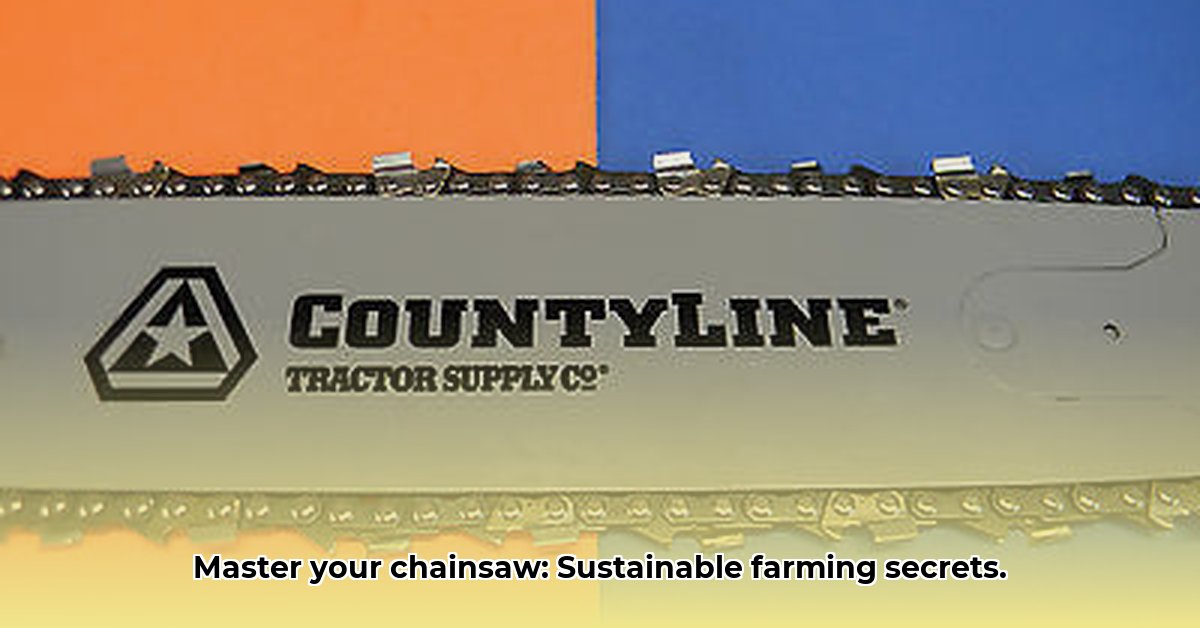
Choosing the Right Tractor Supply Chainsaw Bar: A Sustainable Approach
Selecting the appropriate chainsaw bar significantly impacts efficiency and safety in sustainable agriculture. Bar length directly correlates with task size; longer bars (20 inches+) excel at felling larger trees for pastureland improvement, while shorter bars (12-16 inches) are ideal for precise orchard pruning, maximizing fruit yields. Don't forget to check your chainsaw's manual for compatible bar sizes. Using an incompatible bar is dangerous and inefficient.
Gauge, referring to bar thickness, also influences performance. Heavier gauges (.058") offer superior durability for heavy-duty tasks but increase weight, potentially causing fatigue. Lighter gauges (.050") are easier to handle but may wear out faster. Consider the frequency and intensity of your work when making your selection. For occasional pruning, a lighter gauge may suffice; for regular, demanding use, a heavier gauge is a more sustainable long-term investment. Are you prioritizing maneuverability or longevity?
Maintaining Your Tractor Supply Chainsaw Bar: A Key to Sustainability
Proper maintenance is paramount for safety and efficiency. Regular lubrication with high-quality bar oil is crucial; it minimizes friction, reduces wear, and prevents overheating. A dull chain reduces cutting speed, increases effort, and poses a safety hazard. Regularly inspect your chain for dull or rounded teeth—a clear sign it needs sharpening. Sharpening your chain yourself saves time and money; numerous online tutorials provide guidance. Beyond sharpening, regularly inspect your bar for cracks or bends; damaged bars are safety hazards requiring immediate replacement. How often do you plan to inspect your bar and chain?
Safe Chainsaw Operation: Prioritizing Safety in Sustainable Farming
Safety must always be the top priority when using a chainsaw. Always wear appropriate personal protective equipment (PPE), including safety glasses, hearing protection, chainsaw chaps, and heavy-duty gloves. Thoroughly inspect your chainsaw and bar before each use. Never operate a chainsaw when tired or under the influence of substances. Plan your cuts carefully; consider the tree's lean, potential fall direction, and ensure a clear escape route. Learn and apply proper felling techniques. Don't exceed your skill level; when uncertain, seek guidance from experienced professionals. What safety measures do you have in place?
Tractor Supply Chainsaw Bars in Sustainable Agriculture: Practical Applications
Tractor Supply chainsaw bars are versatile tools for diverse sustainable agriculture practices. In agroforestry, selective pruning maximizes tree growth and yields valuable timber, enhancing sustainability. Orchard management relies heavily on precise pruning for optimal fruit production. Woodland clearing for pasture improvement benefits from selective clearing, promoting ecological balance. Even selective logging gains from a chainsaw's precision. How will you integrate chainsaw use into your sustainable farming strategies?
Comparing Tractor Supply Chainsaw Bars: Making an Informed Choice
Tractor Supply offers various chainsaw bars. Factors to consider include chainsaw engine size, task type, and budget. Some bars are designed for particular applications; review product specifications carefully. Low-vibration models reduce operator fatigue, increasing efficiency. Longer bars extend reach but add weight. Customer reviews provide valuable insights into real-world performance. The optimal bar is the one best suited to your specific needs and work type. Have you considered the impact of vibration reduction on long-term productivity and sustainability?
Sharpening Your Tractor Supply Chainsaw Bar and Chain: A Step-by-Step Guide
- Secure the Saw: Firmly clamp your chainsaw in a vise for stability.
- Inspect the Chain: Check for damage; replace if necessary.
- Select the Correct File: Use a file designed for your chain type.
- Maintain Proper Angle: Follow the file's guide for the correct filing angle.
- File Each Tooth Evenly: File each tooth consistently, ensuring uniformity.
- Clean and Lubricate: Remove filings and lubricate the bar and chain.
- Test Sharpness: Test the chain to verify a smooth, clean cut.
Overcoming Financial Barriers to Precision Farming: A Chainsaw Analogy
Precision farming offers significant potential, but high initial costs can deter adoption. Proper chainsaw maintenance—a microcosm of sustainable practices—extends its lifespan, maximizing investment. Strategic planning and selection in precision farming yield similar long-term savings. By carefully selecting tools and implementing proper maintenance, farmers can significantly reduce costs associated with equipment.
Key Takeaways:
- Choosing the right chainsaw bar significantly impacts efficiency and sustainability.
- Regular maintenance—lubrication and sharpening—extends bar and chain lifespan, reducing long-term costs.
- Prioritizing safety practices protects both the operator and the equipment investment.
- Sustainable agricultural practices benefit greatly from strategic use of well-maintained tools, promoting efficiency and economic sustainability.